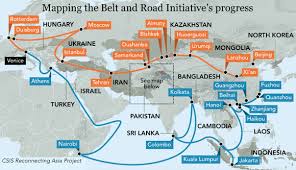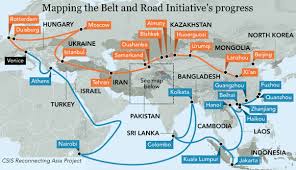
The Belt and Road Initiative (BRI), also known as the One Belt, One Road (OBOR), is a colossal infrastructure and economic development project launched by China in 2013. Spearheaded by Chinese President Xi Jinping, it aims to enhance global trade and stimulate economic growth across Asia and beyond by building a vast network of trade routes reminiscent of the ancient Silk Road.
China’s Massive Belt and Road Initiative | Council on Foreign Relations
Objectives and Scope
The BRI encompasses two main components: the Silk Road Economic Belt, which focuses on land-based routes, and the 21st Century Maritime Silk Road, which emphasizes sea-based routes. These routes aim to connect China with Europe, Africa, and other parts of Asia through infrastructure projects, including railways, highways, ports, and airports.
Economic and Political Implications
China’s Belt and Road Initiative is not just about building infrastructure; it also seeks to foster economic interdependence and strengthen political ties between China and participating countries. By investing in infrastructure projects in over 150 countries, China aims to create new markets for its goods and services, secure access to natural resources, and expand its geopolitical influence.
Military Expansion Concerns
While the BRI is primarily framed as an economic and development initiative, growing concerns exist about its potential military implications. Some analysts argue that the infrastructure projects, particularly ports and railways, could have dual-use capabilities, serving both civilian and military purposes. For instance, Chinese laws mandate that even overseas infrastructure be designed to meet military standards, allowing the military to commandeer ships, facilities, and other assets of Chinese-owned companies. This civil-military fusion approach raises concerns about the potential for China to use BRI projects to expand its military reach and gather intelligence.
Weaponizing the Belt and Road Initiative | Asia Society
Debt Trap Diplomacy
Another significant concern surrounding the BRI is the possibility of debt-trap diplomacy. Critics argue that China uses the initiative to extend large loans to developing countries for infrastructure projects, knowing that these countries may struggle to repay the debt. When countries default on their loans, China can leverage the debt to gain strategic control over key infrastructure assets, such as ports and railways. This practice has been observed in several countries, including Sri Lanka, where China took control of the Hambantota Port after the Sri Lankan government could not repay its loans.
Limited Local Job Growth
While the BRI has the potential to create jobs in participating countries, there are concerns about the limited local job growth due to China’s preference for using Chinese labor. Many BRI projects are implemented by Chinese companies, which often bring in their workers rather than hiring locally. This practice can limit the economic benefits for local communities and reduce opportunities for local workers to gain employment and skills from these projects.
Benefits and Criticisms
Proponents of the BRI argue that it has the potential to usher in a new era of trade and economic growth for participating countries. Improved infrastructure can facilitate trade, create jobs, and boost local economies. Additionally, the initiative can help bridge the infrastructure gap in developing countries, providing them with much-needed investment and development opportunities.
However, the BRI has also faced criticism and skepticism. Some analysts view the initiative as a strategic move by China to expand its influence and control over key trade routes. There are concerns about the debt burden on participating countries, as many have taken on significant loans to finance BRI projects. Critics argue that this could lead to a “debt trap,” where countries become heavily indebted to China and lose control over their infrastructure.
Recent Developments
The BRI has seen both successes and setbacks in recent years. For instance, Panama recently announced its decision to withdraw from the initiative, citing concerns about the benefits it has brought to the country and pressure from the United States. This move highlights the geopolitical tensions surrounding the BRI and China’s challenges in maintaining support for the initiative.
Conclusion
China’s Belt and Road Initiative is an ambitious and far-reaching project that has the potential to reshape global trade and economic dynamics. While it offers significant opportunities for infrastructure development and economic growth, it also raises important questions about debt sustainability, geopolitical influence, and the long-term impact on participating countries. As the BRI continues to evolve, monitoring its progress and addressing its challenges will be crucial to ensure it benefits all parties involved.




